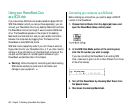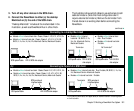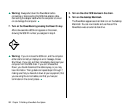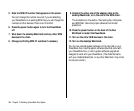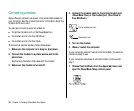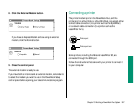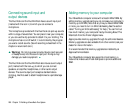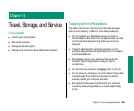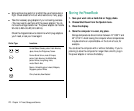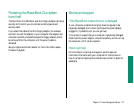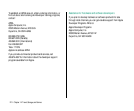
Connecting sound input and
output devices
The Duo Dock and the Duo MiniDock have a sound input port
(marked with the icon X) to which you can connect a
microphone.
The microphone provided with the Duo Dock can pick up sounds
within a range of several feet. You can place it near your computer,
or you can use the clip provided to attach it to your clothing. The
microphone has no on/off switch; it is controlled by the program
you use to record sounds. (Sound recording is described in the
chapter on sound and color.)
s Warning: Do not plug a sound output device (such as a pair
of headphones) into the sound input port. Doing so may
damage your audio equipment.
s
The Duo Dock and the Duo MiniDock also have a sound output
port (marked with the icon -) to which you can connect
speakers, an amplifier, headphones, or other audio output
devices. The sound output port accepts a standard stereo
miniplug, like that used to attach headphones to a portable tape
player.
Adding memory to your computer
Your PowerBook computer comes with at least 4 MB of RAM. By
adding memory upgrade cards you can increase your computer’s
memory up to 24 MB. (Note that any time you have 8 MB of RAM
or more, you need to turn on 32-bit addressing. See the section
called “Turning on 32-bit addressing” for help.) You can find out
how much memory your computer has by choosing About This
Macintosh from the Finder’s Apple menu.
Apple provides memory upgrades through its authorized dealers.
Memory upgrades are also available from other vendors; ask your
dealer for more information.
It is recommended that memory upgrades be installed by an
Apple-authorized dealer.
Your PowerBook computer also supports virtual memory, a
feature that makes use of hard disk space to provide additional
RAM.
268 Chapter 13: Building a PowerBook Duo System



